Intro
You don't have to be an avid watch collector to know that the Breitling name is not only associated with watches, but watches in aviation. Of course their SuperOcean diving-watch line goes all the way back to 1957 but aviation was the basis for Breitling almost from the start. Founded in 1884 (hence the logo "Breitling 1884"), they quickly became experts for chronographs and had patent(s) for their own (pocket-watch) chronograph movements before the turn of the century. 1915 saw
the(ir) first wristwatch chronograph with a separate single pusher and in 1934, Breitling was the
first to patent the dual-pusher chronograph wristwatch. At the same time, Breitling was producing chronograph dashboard-clocks for the cockpit. Breitling formed an own department, "Huit* Aviation", concentrating on aviation - for both professional & military application. Among their "clients" was the RAF (Royal Air force) although I believe their association was mainly for Breitling's dashboard-clocks. Very much aligned with Breitling's exciting history in aviation, I'm pleased to have recently added both their 2019
Navitimer Ref. 806 1959 and 2020
AVI Ref. 765 1953 "Re-Editions" to my humble collection!
* "Huit", french for the number eight, most likely represented the eight-day PR of Breitling's dashboard clocks.
 click-the-pics for hi-res goodness
Navitimer Ref. 806 1959 Re-Edition
click-the-pics for hi-res goodness
Navitimer Ref. 806 1959 Re-Edition
Breitling's Navitimer needs no introduction. In fact, aside from maybe the Super Ocean*, the Navitimer is one of the few Breitling series I would have been able to name,
off the top of my head. Now that I've taken a keen interest in the history of (wristwatch) chronographs, I can name a few more, starting with Breitling's 1942
Chronomat (
Chronograph +
Mathematics). the Chronomat was actually the first reference that made use of the circular sliderule. Roughly 10 years later, Breitling released the iconic Navitimer (
Navigation +
Timer. Among other subtle changes, the Navitmer gained an additional sub-register to track the hours, something quite useful for pilots flying longer distances. The 806 also had the syringe-needle hands as well as the longer 3-6-9-min (sub-reg.) markers typically found on a pilot's chronograph.
*Ok, if I really try, the contemporary Chronomat & Emergency also spring to mind. But Aerospace... Chronospace, Exospace??? ...not-so-much.
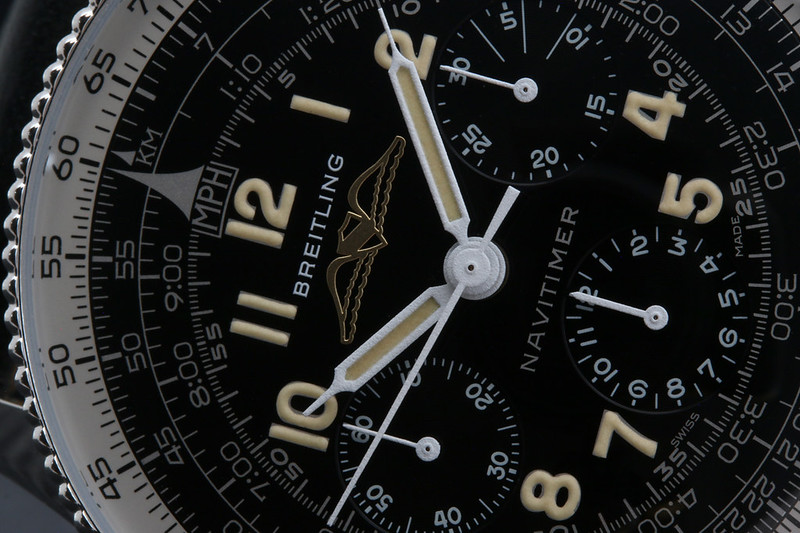
I believe the Navitimer was initially offered to the
AOPA, the American-based
"Aircraft Owners & Pilot's Association". As such, you will note the AOPA golden-wings logo on the initial Navitimers sold in the U.S.A. Breitling also made the Navitimer available outside the U.S. but used their applied "cursive B" logo instead of AOPA's and also added
Breitling & Genève to the "three-liner" dial. Like many references that have enjoyed a long life, the Navitimer saw several cosmetic changes. Among the variations was a 1959 version that had the AOPA golden wings but without the "AOPA" characters as well as "Breitling Genève" and Breitling chose this variation for their Re-edition. As they are no longer based in Génève, Breitling left it off the dial for the Re-edition. Of course the Navitimer continued to be produced and new variations appeared, including 1963's big change to a reverse-Panda color scheme as well as updated hands. In 1964 and onward, along with the AOPA logo, Breitling released Navitimers with their own
"two planes in formation" logo. If you want to learn about even more variations, be sure to visit Navitimer collector
Kurt Broendum's website.

Every Navitimer comes with a User Guide that includes some examples of how to make use of the
circular slide-rule. The late Chuck Maddox has a scan of an
original 806 user guide. While much simpler than a formal slide rule (see below), the Navitimer, using basic multiplication and division was used by the pilot to calculate useful flight-specific data
(time-speed-distance computations) - fuel consumption, for example. Although the two outer-most scales represent the basic (C&D) slide rule scales, the Navitimer is after all intended for aviation. The "MPH" & large arrow represent the ground-speed (or hour) index for "quantities per hour" calculations. The third scale is referred to as a "double-time" scale for long-distance use. So we see that the "1:10" is aligned with 70, 2:00 with 120 and so on, all the way up to 10hrs
(8:20 = 500mins, 9:10 = 550mins, ...). The 4th scale is standard minutes.
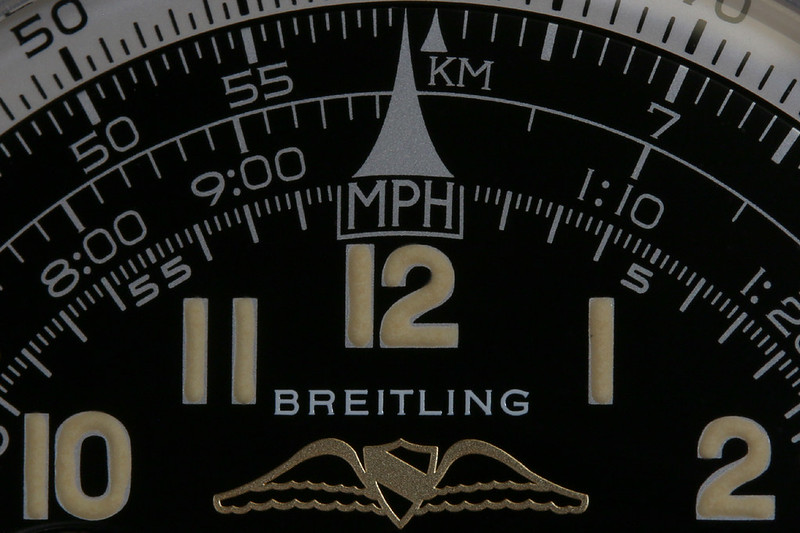
I have always managed to have some connection with each watch that I've acquired and in a roundabout way, this includes the Navitimer. Like many students in the 50s, 60s
(pre-1972, Scientific-calculators era), my father used a slide rule in school. One of my favorite stories was that during a math/physics class, his instructor asked the class to calculate the location of the
Sputnik 1 satellite (4~26 Oct 1957). Given that Sputnik orbited the Earth every 96 mins at a 65° inclination made it possible for the instructor to know that Sputnik would be visible from their school during his course. Needless to say the
slide rule was quite useful in calculations such as this... !
 For illustration purposes, I set both slide rule & Navitimer with a multiplier of two.
For illustration purposes, I set both slide rule & Navitimer with a multiplier of two.
The black 10 is aligned with the white 20; If you now look at any black value, the white counterpart will show the result.
Thus, the black 6 (at the 12 o'clock position) multiplied by two results in 12.
AVI Ref. 765 1953 Re-Edition
If you're a vintage Flieger / Pilot-watch collector, the 765 also needs no intro, but for the rest of us it doesn't quite have the iconic status of the Navitimer. The AVIation reference 765 debuted in 1953 and this just happens to be the time that the watch industry was busy negotiating military contracts with various countries. This is also roughly the time that Breguet
(via Mathey-Tissot), among others, began working on the iconic "Type 20" Flyback pilot-chronograph for the French Air Force & Naval AF. The basic requirements for such a pilot chronograph was
a black dial with large, legible and "illuminated" Arabic numerals. A bi-directional bezel was also requested. Some of the candidates also used a minutes sub-dial that was either bigger in size ("Big Eye") or included illuminated markers, emphasizing the sub-register's importance for pilots (pre-flight check, way-point navigation, course-corrections etc.) In terms of complications, a Type-20 contender had to have a Flyback function, which the 765 did not have (not that Breitling was a bidder). Breitling was much more involved on
the commercial side of piloting. They equipped the 765 with a 15-min sub-register instead of the typical 30-min; the primary purpose of this was for the
pre-flight check which should take 15 mins, no more. Breitling also added a lumed marker every three mins. Note the 806, like many pilot watches of the period, used longer 3-6-9-min markers and the 765 placed more emphasis with the use of the lume.

Just like the 806, the 765 had its own series of updates. In fact, even in 1953 - the first year of production, there were two distinct variations - the one that the re-edition is based on as well as
a variation with a "digital" 15-min counter in lieu of the analog sub-register. Just like the Navitimer, Breitling went with a reverse-panda scheme in the early sixties. In the mid-sixties, Breitling replaced the SS bezel with a more contemporary black-anodized Al. bezel, greatly aiding in legibility. At the same time, they chose to replace the "AVI" prefix with the more popular
Co-Pilot (CP) moniker.

On the
commercial side of this era,
Breguet makes for the perfect comparison with Breitling, given that Breguet's 1959
Type XX (consumer version of the Type 20) share many similarities to the 765. While many avid collectors will single out the Type XX as "the" original in this segment, the release dates
(765 in 1953, XX in 1959*) suggest otherwise. This is an argument that
Fred Mandelbaum, an avid vintage collector and
consultant with today's Breitling team, is more than willing to uphold... .
*While Breguet had marketed the XX and/or prototypes prior to 1959, they had only two sub-registers and thus were not the version represented by their contemporary XX models.
 Re-editions
Re-editions
In fact, Fred (aka
Watchfred on IG and other social networks) was directly involved in the development of both the 806 & 765 Re-editions with Breitling's team. Fred's an avid collector of vintage chronographs and other genres and specializes in Breitling vintage pieces. The 806 and 765 re-editions were patterned after his own vintage pieces. I've read that the design team put in a lot of effort in order to make the re-editions as close to their original counterparts as possible. Everything from the fonts to the colors and even the exact same number of "beads" of the (1959) Navitimer's bezel-edge were taken into account. While I cannot confirm this, I've been told that the Navitimer's lumed numerals were
hand-painted as it was the only way to match the font & look of the original!
 Despite a lack of "accuracy" when seen under the loupe, the lumed numerals not only look perfect in real-world use,
Despite a lack of "accuracy" when seen under the loupe, the lumed numerals not only look perfect in real-world use,
but are quite bright and crsip when "charged".
In terms of case dimensions, Breitling of course had to work around the modern heart of the watches, the Breitling
in-house B09 movement. The B09 is essentially a hand-wound version of their now-established 2009
B01 chronograph movement. The vertical-clutch & column-wheel based B01/B09 have a lot going for them; excellent accuracy through design and adjusted to provide COSC standards. A PR of 70hrs and seconds-hack are additional proof of the up-to-date design. Of course the B09 and original Venus 178 movement (used in both the 806 & 765) are not identical in size, but despite this, the overall case-diameter is 41mm, much like their original counterparts. Ditto for the 22mm lug widths. I was informed that the pusher-stems on the re-editions had to be longer than the originals due to the difference in movements, but only a die-hard, vintage-Breitling buff (like Fred) would pick up on this unavoidable variation. While at first glance, the crowns (of the two re-editions) appear to be identical, they do differ slightly (6.5 vs. 7.0mm) - I assume in order to match their original counterparts.

I believe both the 806 & 765 re-editions use the same case but their heights differ somewhat (14 vs 14.5mm), mainly due to the different crystals and/or caseback-types used. Speaking of which, once again Breitling did their best to replicate the originals in terms of the crystals' geometry as well as going with Hesalite (plexi)! The Navitimer enjoys a simple (super-)domed Hesalite crystal whereas the 765's Hesalite has a "boxed" geometry as did the originals respectively. Moving to the rear side of the watch, we see that the Navitimer uses a "driven"
(read: snap-on) caseback whereas the 765 use a screw-down caseback, both solid. This has nothing to do with water resistance
(both rated at 3 BAR/Atm) or cost, rather once more, Breitling chose to remain
faithful to the original designs.
 Re-edition vs. real-edition...
Re-edition vs. real-edition...
I'm very grateful to Breitling for having taken this step and the reason being, the "re-edition" is the perfect watch style for someone like me. I absolutely love the design-grammar used back in the 50s and 60s. You'd think that would make me an avid vintage collector, but I'm not, for several reasons. The main reason is that as a perfectionist, I'd be drawn to only pieces in excellent condition, preferably with papers, etc. This is a very costly affair, as you can imagine.
Secondly, it's not a simple affair as you must have an excellent overview of the models and all the possible variations in order to know what is a real find and conversely, what might very well be a fake or "frankenwatch". The paperwork alone is not enough; this is where "provenance" is not only desirable, but at times becomes a necessity to ensure the authenticity of the piece. The re-editions provide me with that vintage flavor, minus the cost* & risk!
*Albeit some re-editions are rivaling their vintage inspirations in terms of cost now days...
While Breitling is not the only or even first brand to revisit their historical roots with re-editions, few actually come this close to their vintage brethren. Most brands have gone with "tributes" which represent the original design with a modern flare (or vice versa). Omega and Seiko did an awesome job with the re-creation of some of their iconic watches, including Omega's 1957 Speedmaster, Seamaster & Railmaster; Seiko brought their 1967 "62mas" back to life as the SLA017. Now Breitling has joined such brands in honoring their legacy with these excellent re-editions!
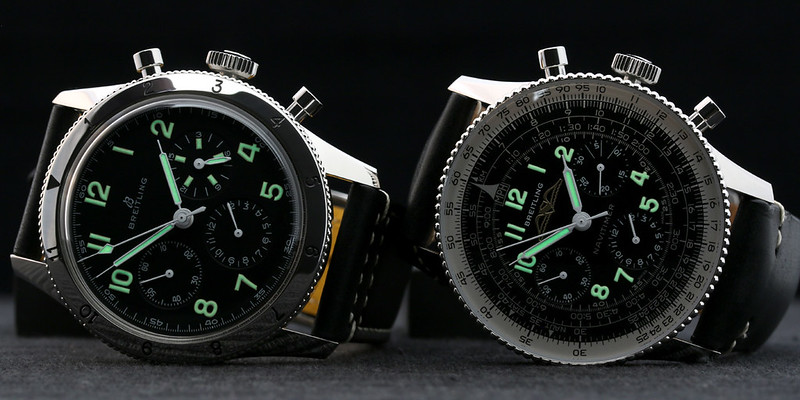 King Georges
King Georges
One of the final (pre-Quartz) milestones for Breitling was their participation along with
Heuer-Leonidas, Hamiliton-Buren and Dubois Depraz in the joint-effort to design (one of) the first automatic Chronograph movements (Calibre 11). A profitable venture indeed, at least for the first half of the seventies... . As with many established brands, Breitling had to suffer through the 1975 "Quartz Crisis". In 1979, Breitling sold the brand to the Ernst
Schneider family. They were responsible for the "return" of the brand to the market, taking a then-modern approach and launching the 1st of the next-gen Breitlings under the
Chronomat label. The Navitimer was resurrected and the Emergency as well as Aerospace were introduced under their leadership. Successful to be sure, but (IMO) quite a different direction compared with the Breitling of the past... .
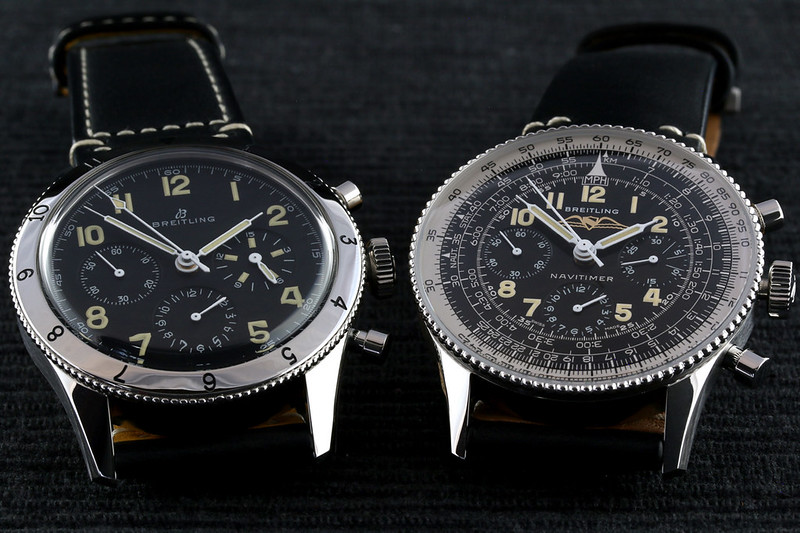
Breitling was recently sold to a European private-equity firm,
CVC Capital Partners. This 2017 transformation continued with a "changing of the Guard" when
G. Kern (former CEO of Richemont's IWC, B&M & Roger Dubuis) took the reigns.
Some have welcomed the change, others were instead somewhat concerned. Kern's
"surf's up - get Brad Pitt a board" approach seems to have rattled some of the Breitling / Schneider-era veterans. As I haven't closely followed Breitling in the past decades, I'm not in the position to judge (but welcome opinions from all). I am, however, very grateful to "Team-Kern" for drawing on Breitling's rich heritage and in turn, bringing these two excellent vintage references back to life. Perhaps I didn't make enough of an effort to follow Breitling in the (recent) past, but they are firmly on my radar now and I'm looking forward to seeing what Kern's Breitling has in store for us in 2021! Until then, I can assure you I'm going to thoroughly enjoy wearing both of these fantastic re-editions!

~~~~
click-the-pics for hi-res goodness




 Note there are exactly three screws securing the 765's bezel - another nod to the original's design!
Note there are exactly three screws securing the 765's bezel - another nod to the original's design!
 The 806's snap-on caseback and back of lugs are brushed for a nice contrast. Note the LE# has been masked
The 806's snap-on caseback and back of lugs are brushed for a nice contrast. Note the LE# has been masked
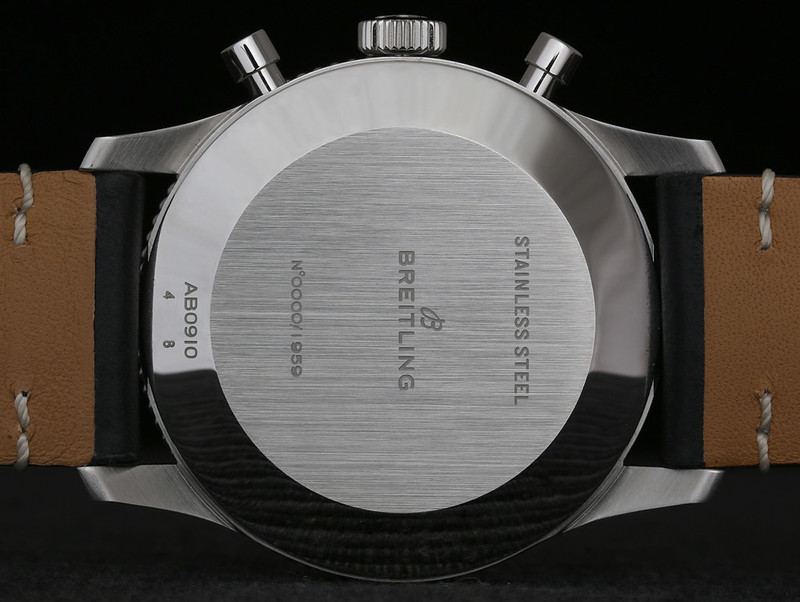 In contrast to the 806, the 765 uses a simplified LE-format with the "One of 1953"
In contrast to the 806, the 765 uses a simplified LE-format with the "One of 1953"
 A 22-18 taperd & "filled" pilot-style strap. Good-looking but at 120/75,
A 22-18 taperd & "filled" pilot-style strap. Good-looking but at 120/75,
not for everyone and certainly not for hot summer days...
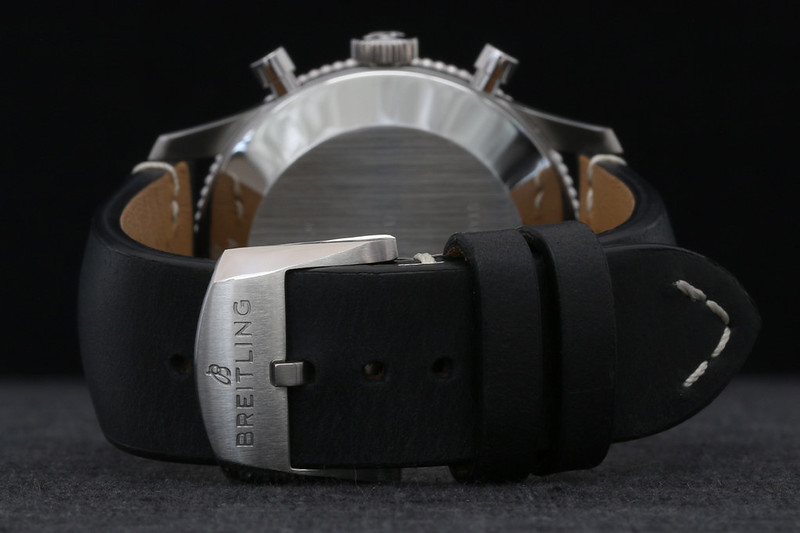 A 22-18 tapered, flat but decently-thick pilot-style strap with nice stitching.
A 22-18 tapered, flat but decently-thick pilot-style strap with nice stitching.
At 120/75, not for everyone and certainly not for hot summer days...
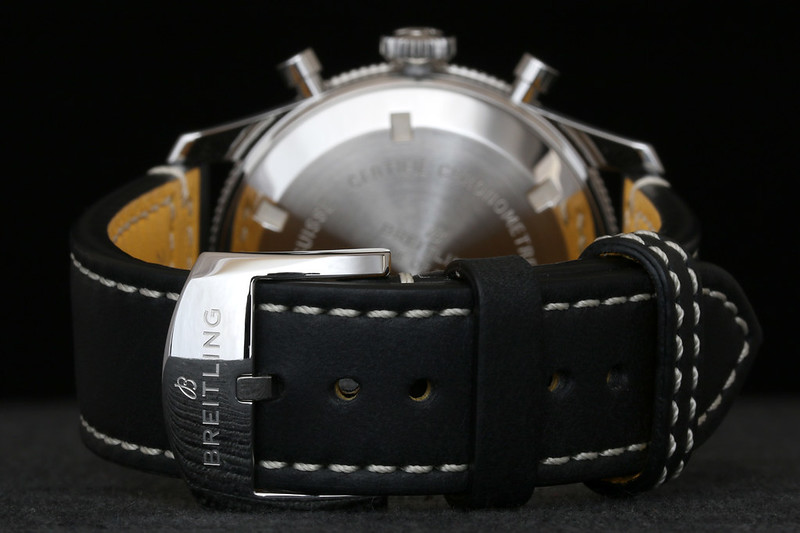 Note the "textured" finish of the 806's hands, in contrast to the 765's gloss finish...
Note the "textured" finish of the 806's hands, in contrast to the 765's gloss finish...
 The Super-Luminova is VERY effective, as it should be for a pilot watch!
The Super-Luminova is VERY effective, as it should be for a pilot watch!
 The Super-Luminova application is quite crisp and very effective - a plus for the re-edition!
The Super-Luminova application is quite crisp and very effective - a plus for the re-edition!
 With such perfect design grammer, the 765 is simply awesomeness...
With such perfect design grammer, the 765 is simply awesomeness...

~~~~
Just for fun; 42mm auto-racing vs 41mm pilot chronograph...

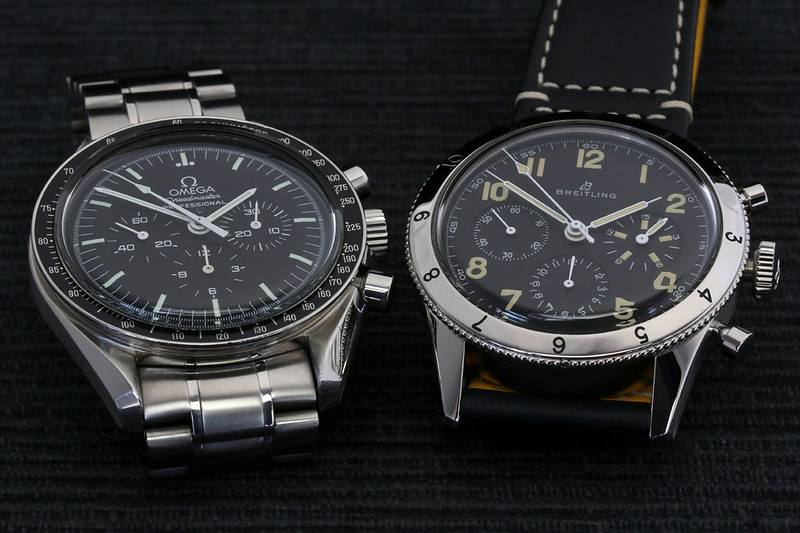
~~~~